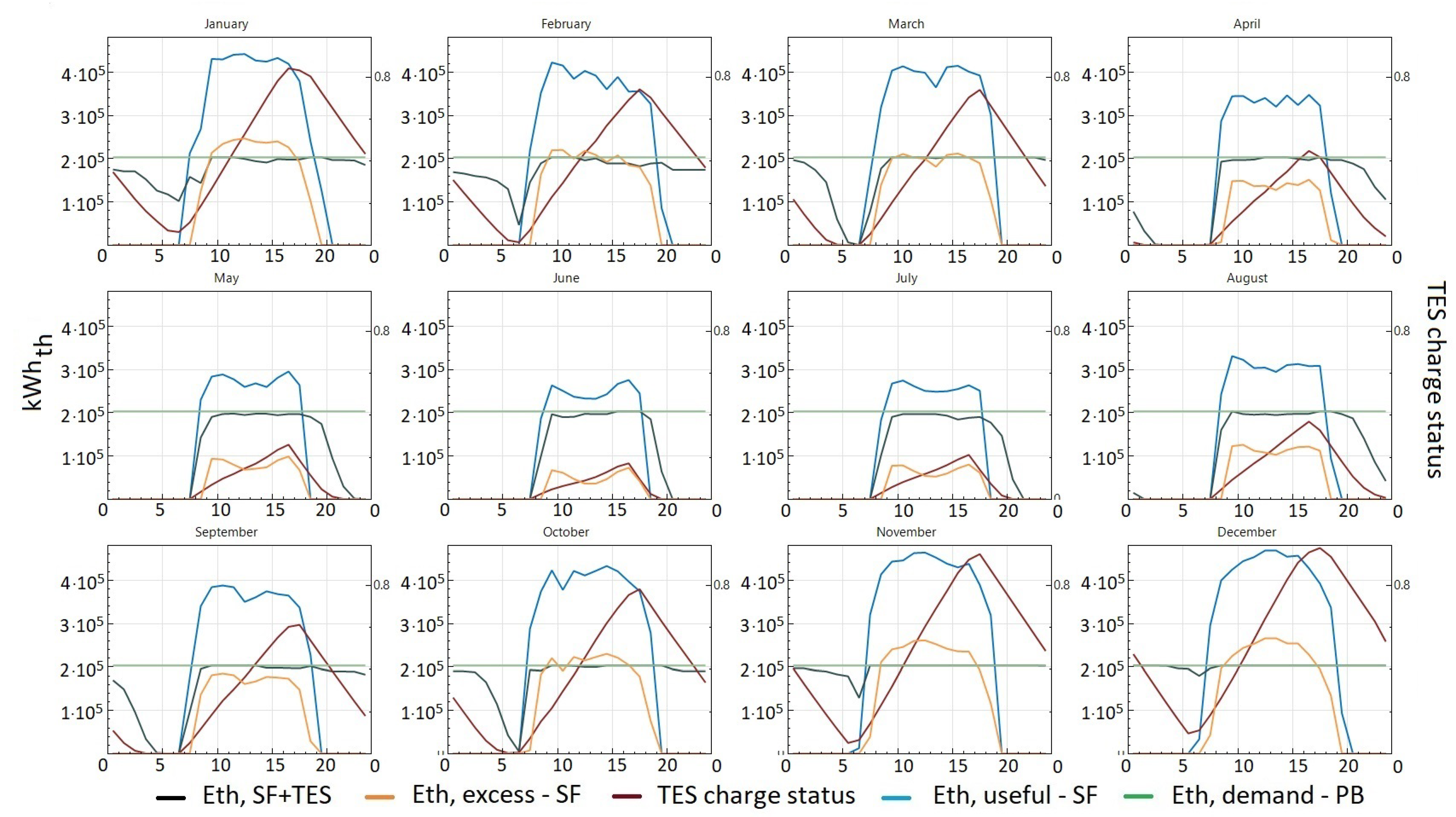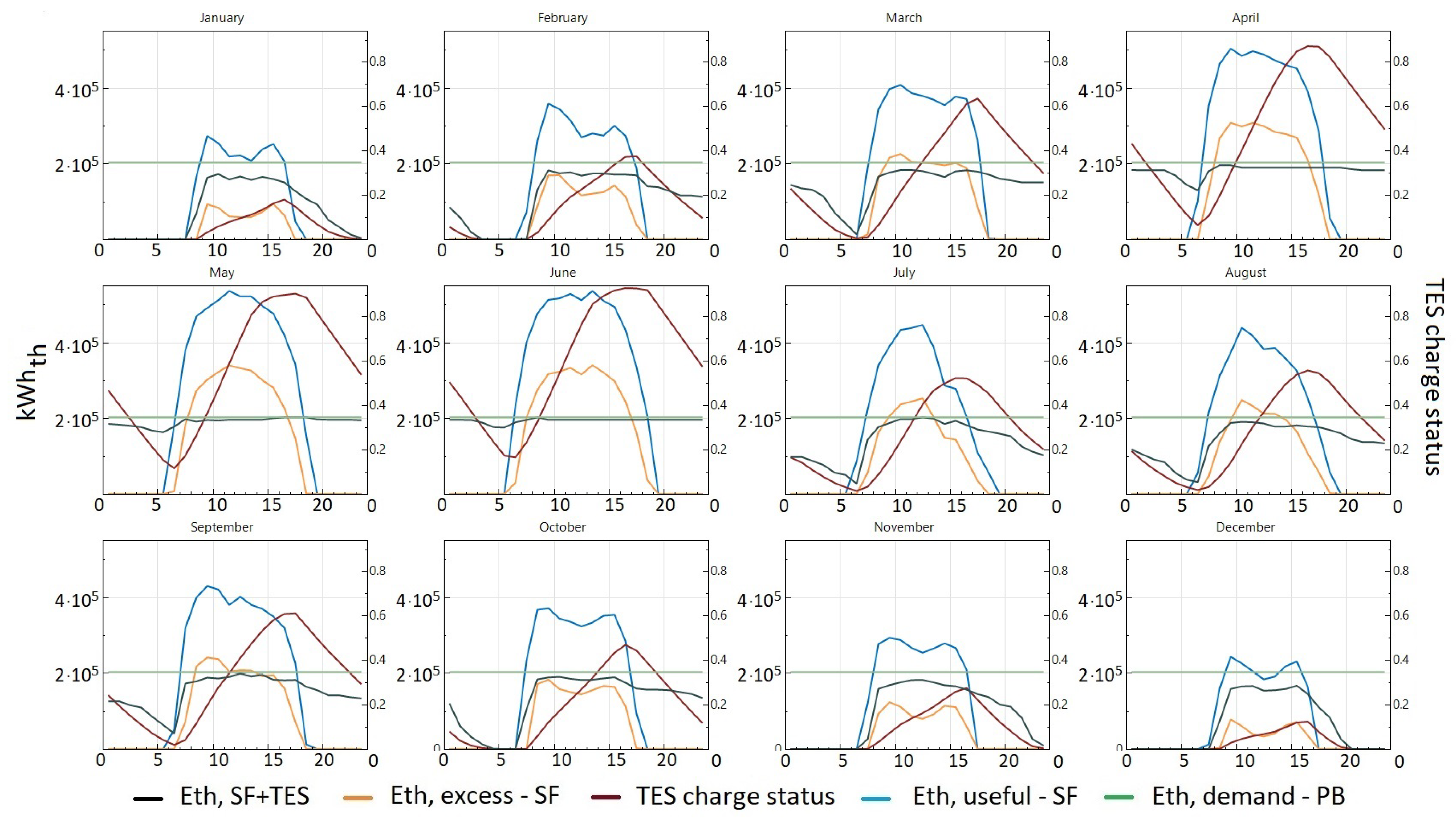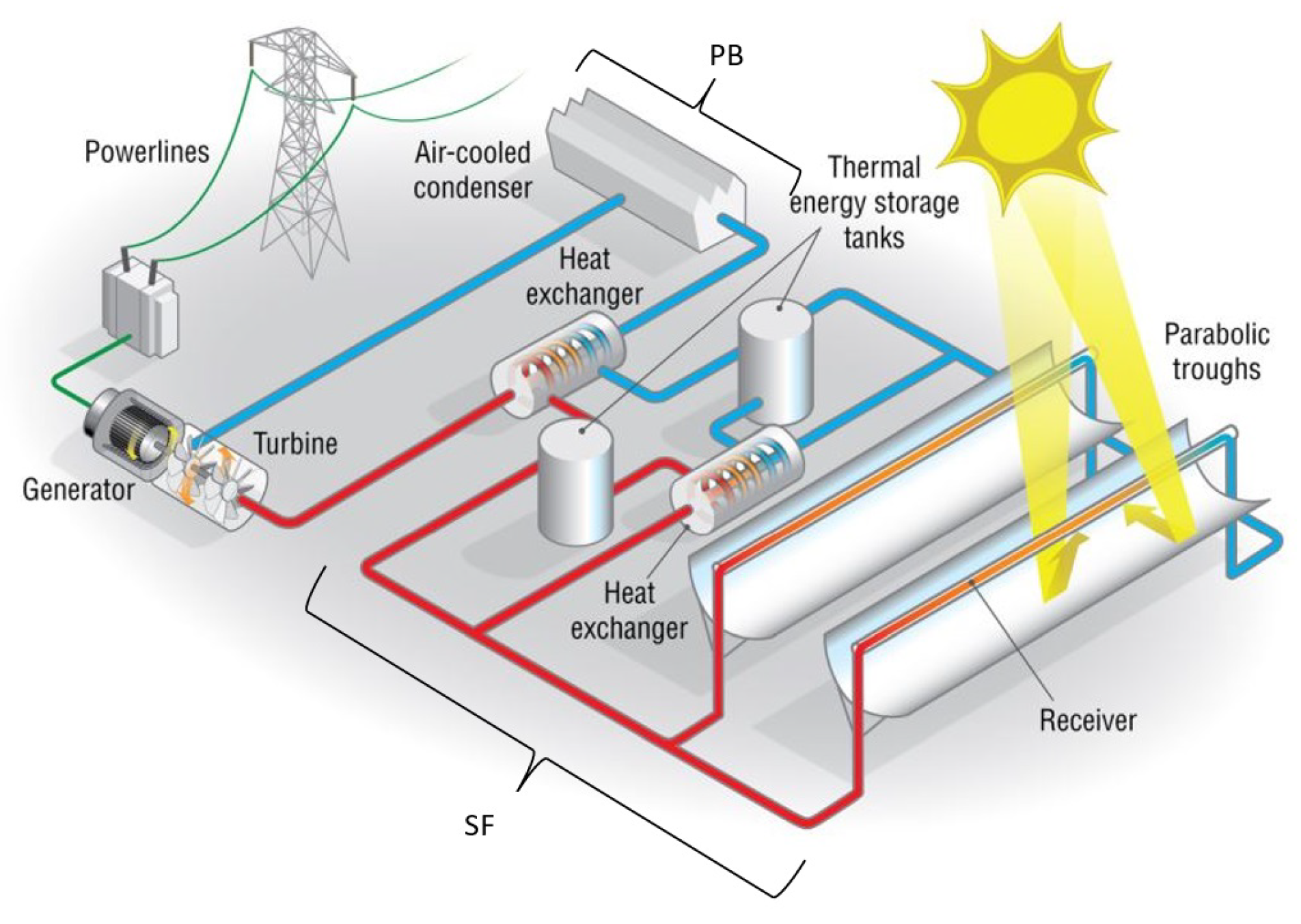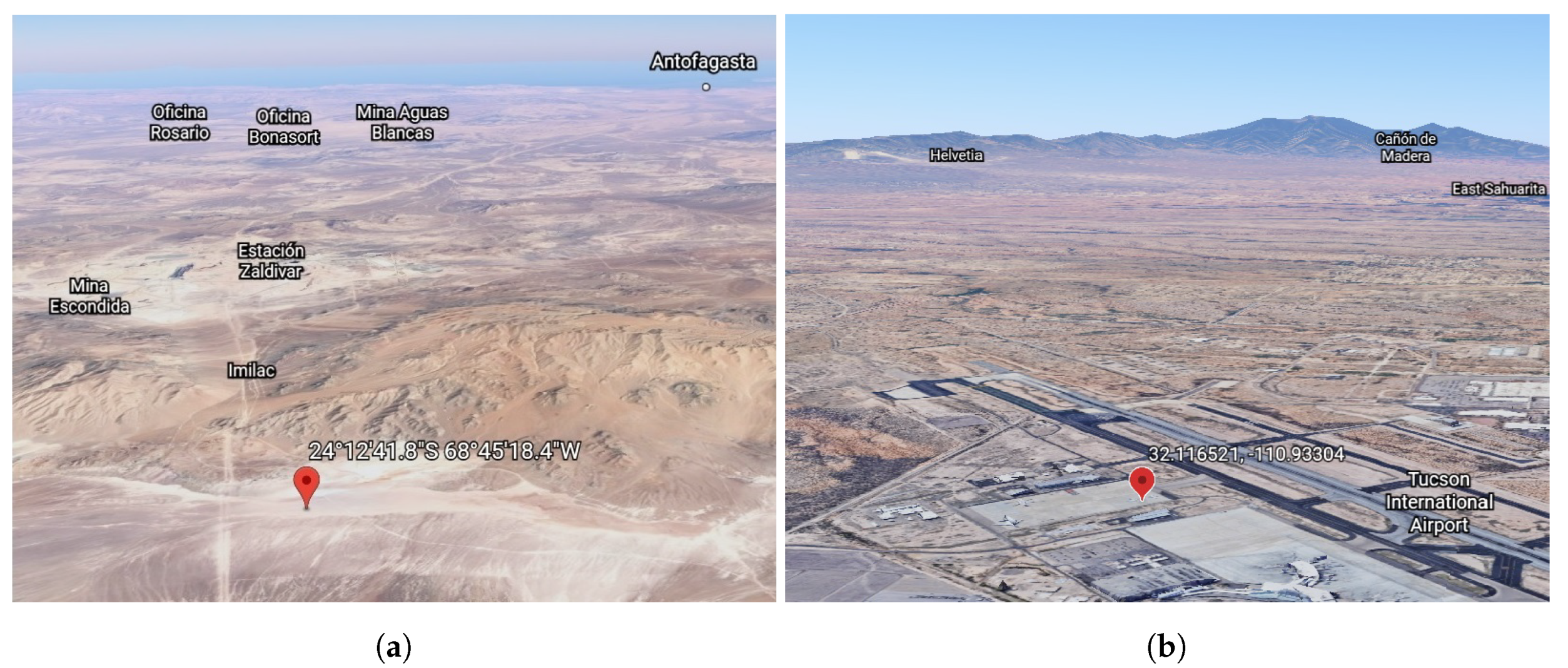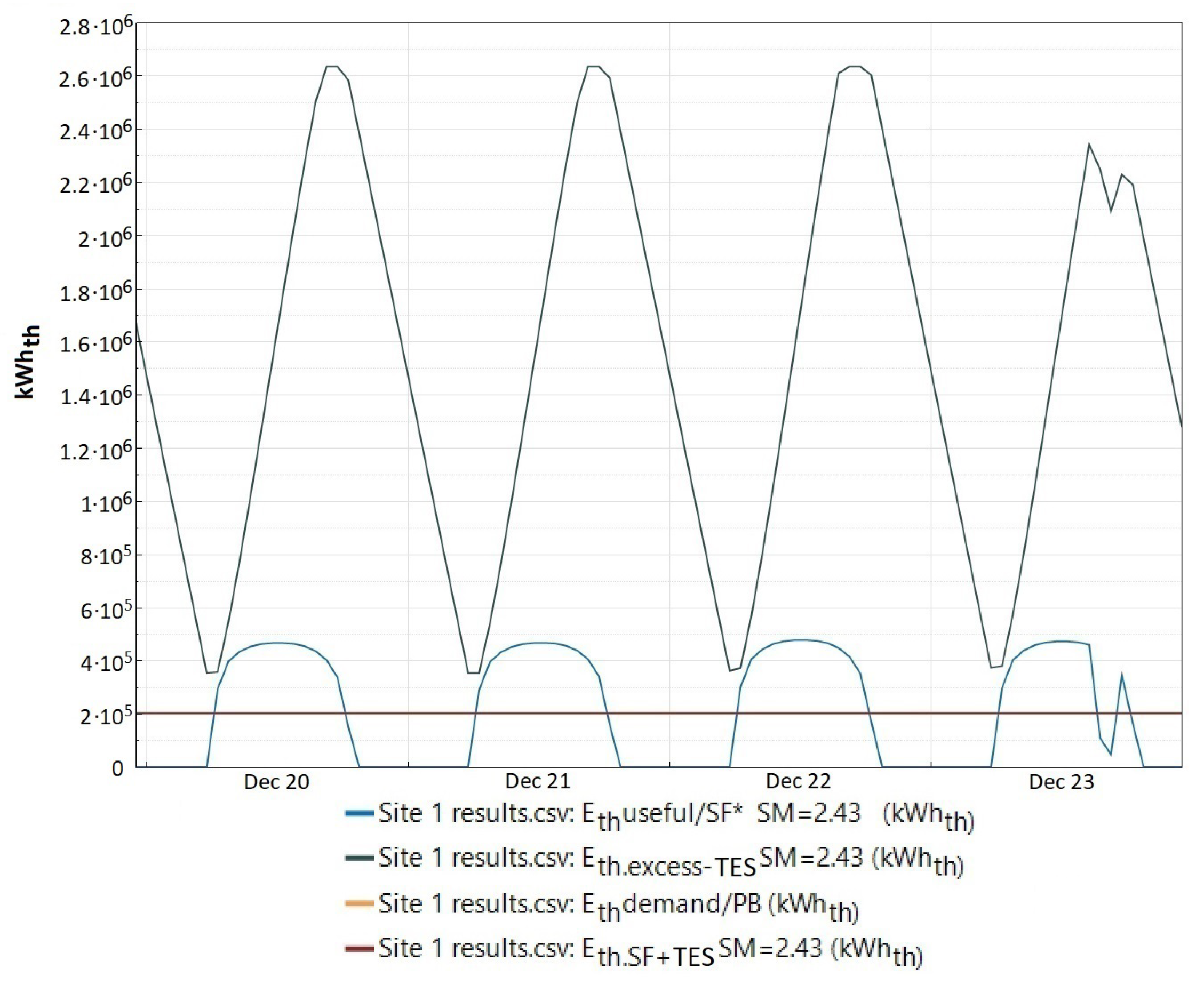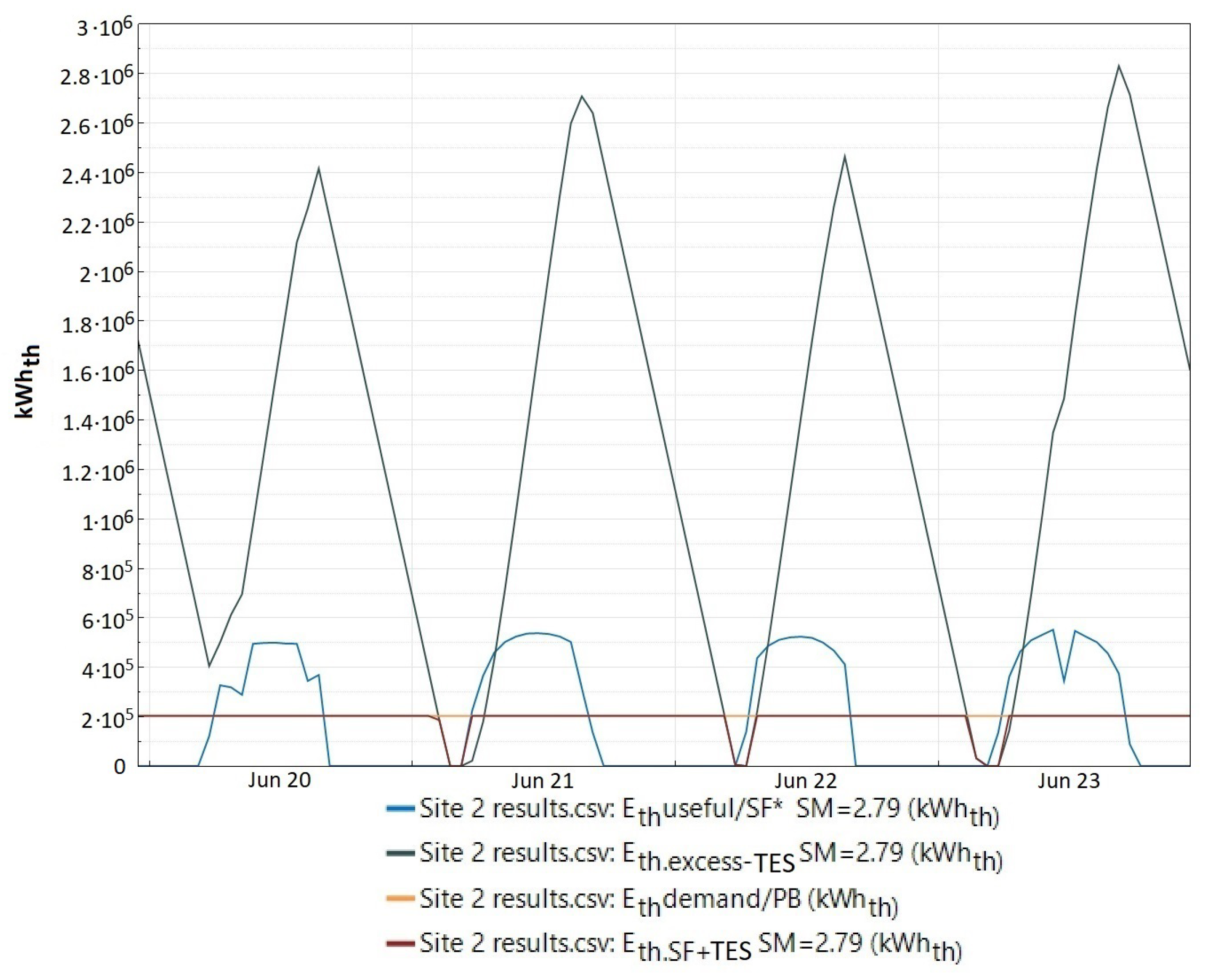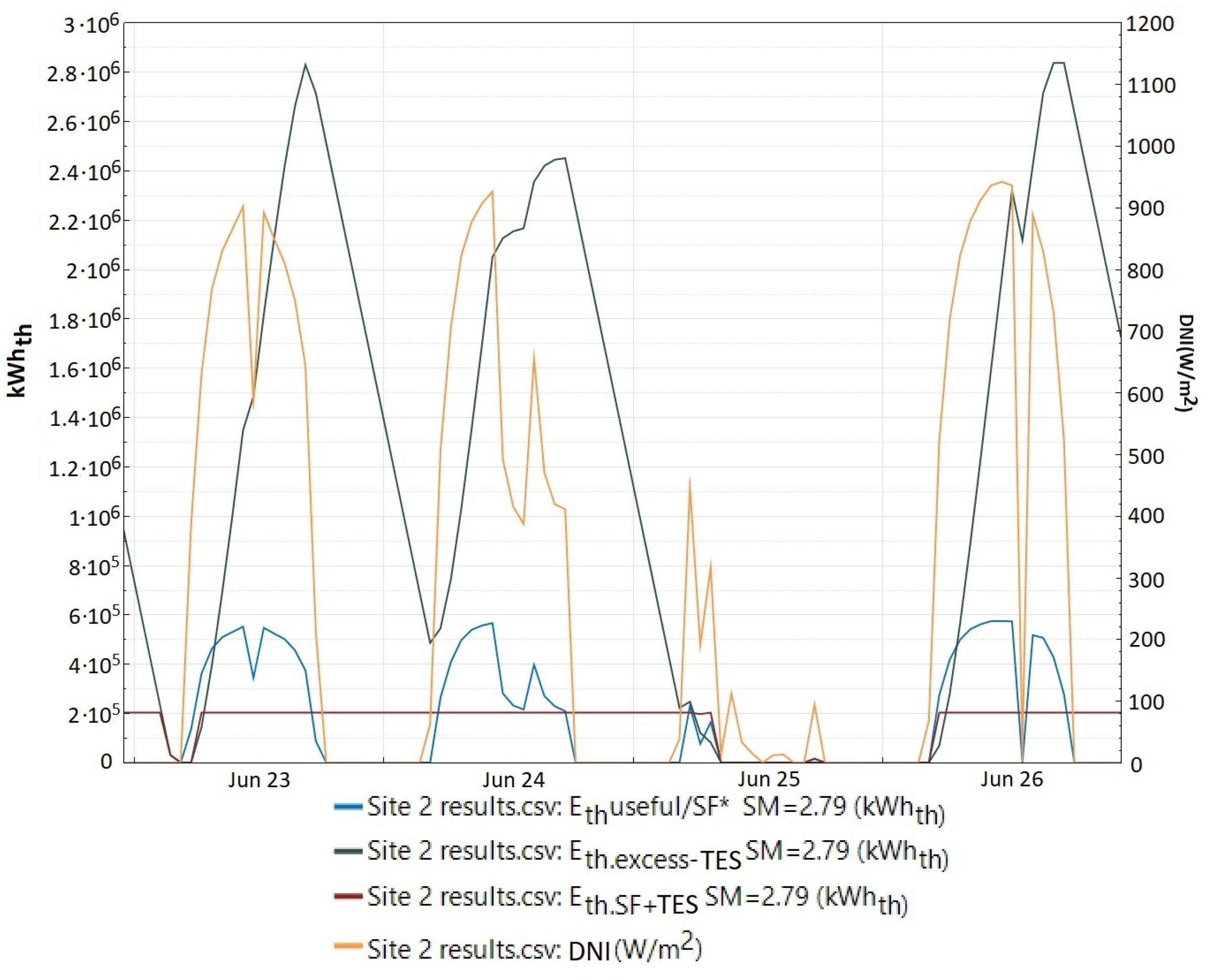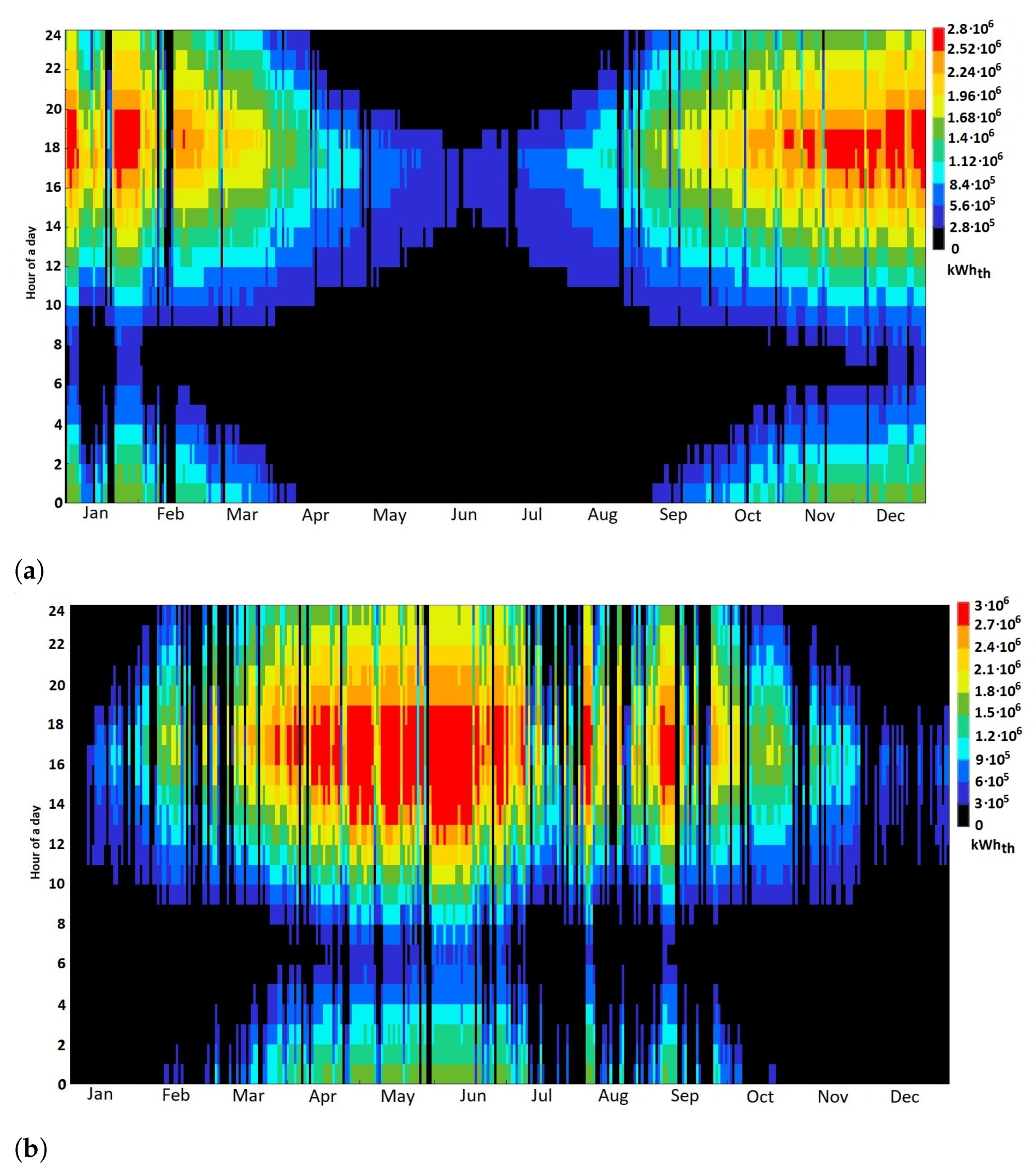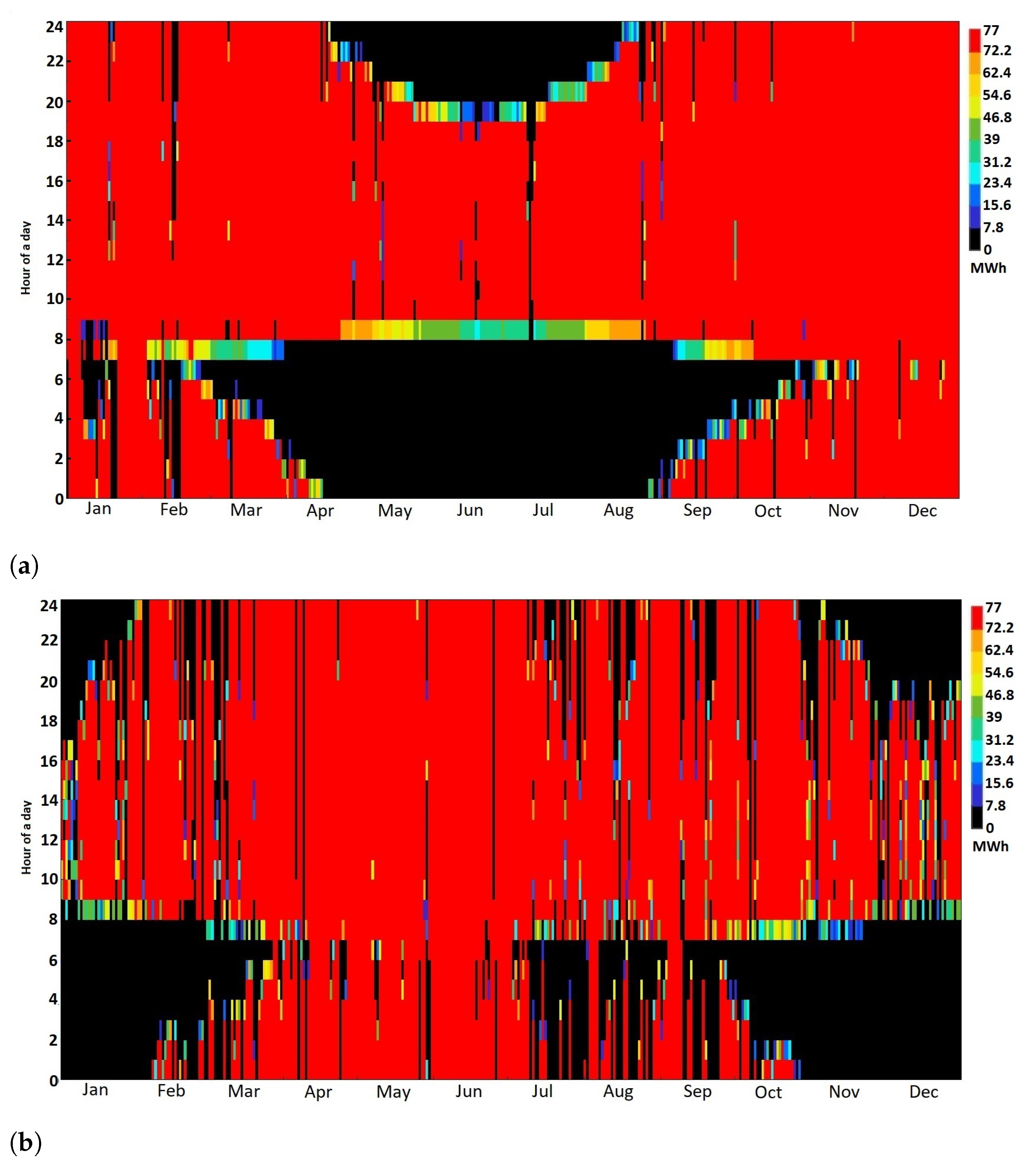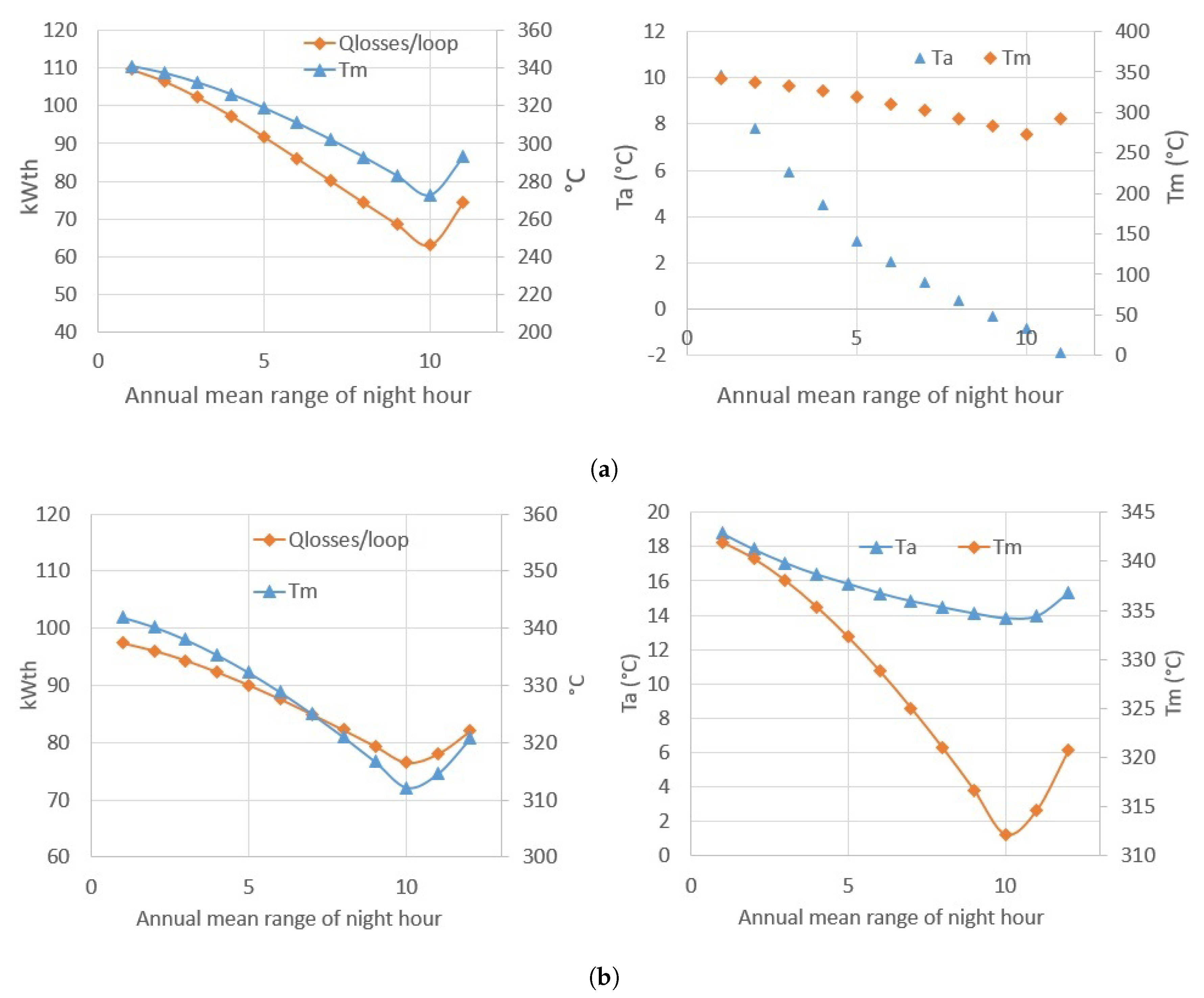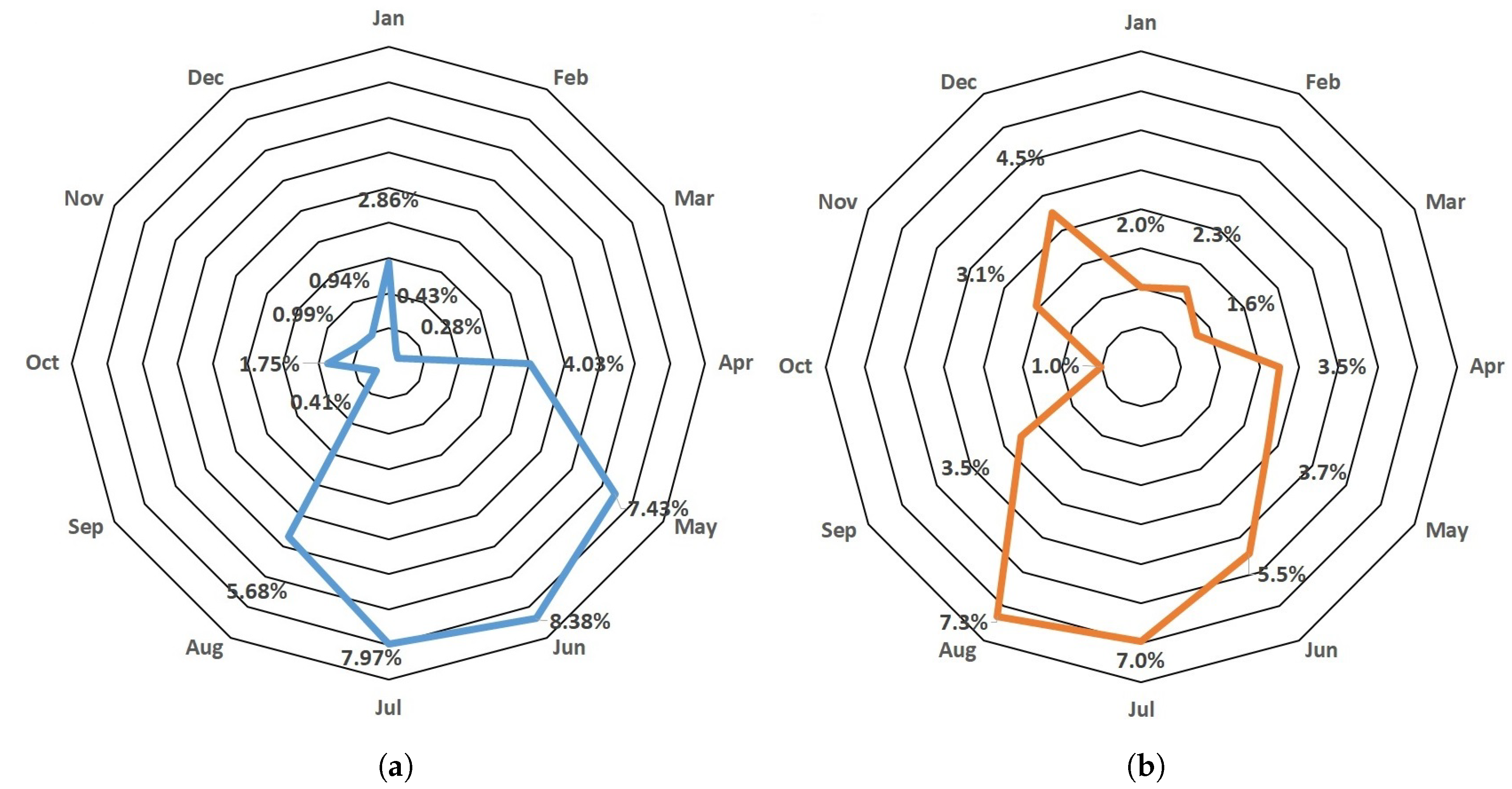1. Introduction
The global energy demand in the first quarter of 2020 declined by 3.8%, or 150 million tons of oil equivalent (Mtoe), relative to the first quarter of 2019, reversing all of the energy demand growth of 2019 [
1]. Nevertheless, it is estimated that the global energy will reach 18,608 Mtoe by 2035 [
2]. For this reason, concentrating solar thermal power (CSP) plants with parabolic-trough (PT) collector technology are a feasible solution for providing coverage for part of the progressive growth of global energy demand. This is reflected by observing the commercial status of parabolic-trough solar thermal power plants (PTSTPPs), which have experienced an important growth. The worldwide installed capacity of PTSTPPs reached 4.7 GWe at the beginning of 2019, which represents a 643.7% increase between 2009 and 2019 [
3], thus positioning the PT technology as the most mature CSP technology in the world.
To date, large-scale numerical-model computer simulations have been used in the design of PTSTPPs, which compute all energy flows as a function of the meteorological data and operating variables. Usually, these models are too specific and complex and do not include the complete PTSTPP, modeling only some subsystems [
4]. In the same way, many simulations preclude a clear physical understanding of how the performance of the plant varies with the input and operational variables; usually, these models are based on cumbersome encoded and unalterable numerical procedures [
5,
6,
7]. In addition, according to what is mentioned by Wei, S. et al. [
8], these models are usually constructed to model the behavior of variables that are specific to solar field (SF) components of a PTSTPP, so in addition to the fact that they are rather cumbersome models and do not allow one to model a PTSTPP globally, they tend to have a high computational cost.
Due to the above, the development of mathematical models that minimize the uncertainty of results with a high degree of adaptability and that integrate international practical/operational experience is of high relevance because they help in decision-making, especially related to locations lacking this experience, and they allow the observation of the behavior of the main variables that characterize the system.
In order to solve such problems, a simplified quasi-dynamic model is presented in this paper, which allows one to model and characterize the thermal behavior of the most important parameters of the solar field (SF) of a PTSTPP (i.e., the useful thermal energy delivered by each collector loop, the useful thermal energy of the SF, the surplus thermal energy of the SF, the surplus thermal energy stored in the thermal energy storage (TES) system, and the thermal energy jointly provided by the SF and the TES) on an hourly time scale. Moreover, equations for modeling the evolution of the hourly gross and net electric power generation were developed. For the evaluation of this model, two geographical locations were selected—one in each hemisphere—of which a typical meteorological year (TMY) file was obtained to perform the simulation. The simulation results obtained with the simplified mathematical model presented in this paper and the independent simulations made with the System Advisor Model (SAM) software [
9] were compared to evaluate the differences between both results and to make clear the multiple benefits of the simplified model.
The rest of this paper is organized as follows.
Section 2 introduces the main concepts related with PTSTPPs;
Section 3 presents the methodological procedure followed;
Section 4 shows the cases under study; design conditions are mentioned in
Section 5;
Section 6 presents the simplified mathematical model used throughout this work; a discussion and the results are shown in
Section 7, which presents the results and their comparison with the simulation results obtained with the SAM. The conclusions are given in
Section 8.
The model of parabolic-trough solar thermal power plants (PTSTPPs) presented in this paper has two main innovations when compared with previous models:
Outstanding simplification of the daily overnight thermal loss modeling by using an average plant overnight thermal loss that is calculated using the average overnight ambient temperature profile obtained from the TMY (typical meteorological year) data. This is explained in
Section 7.2.
The use of several logic functions described in
Section 6 allows the plant performance simulation under transients with a very good balance between the model complexity and the accuracy of the results obtained. The logic functions proposed easily identify and take into account the boundary conditions, which would otherwise require a dynamic model. So, for instance, solar radiation changes due to dawn, sunset, or transients during sunlight hours are identified and modeled in a proper manner with easy computation. The use of these logic functions to perform quasi-dynamic plant simulations with extremely low computation requirements has not been previously reported in the literature.
2. Parabolic-Trough Solar Thermal Power Plants (PTSTPPs)
Basically, a PTSTPP is a power plant using concentrated solar radiation—specifically, the direct normal irradiance (DNI) is the primary energy source, which is concentrated and converted into thermal energy in the form of sensible or latent heat of a heat transfer fluid (HTF), which subsequently transfers this thermal energy to the power block (PB) through a set of heat exchangers for high-pressure steam generation, which is used to drive a steam turbine.
This turbine is connected to a generator that converts mechanical energy into electric energy, which is finally delivered to the external electricity grid. The concentration of the DNI in the SF is achieved by a series of parabolic mirrors that are mounted in a metal structure, thus forming the parabolic-trough collectors (PTC). These PTCs concentrate solar energy on a focal line in which a receiver tube is located to transfer heat to the HTF circulating inside [
10].
A typical PTSTPP configuration is shown in
Figure 1. This figure shows the main components of the SF, such as the PTCs, receiver tubes, and TES, as well as the PB. The TES is used to generate electricity in the absence of solar radiation at night and to supply the SF’s useful thermal energy deficiencies from DNI transients during sunlight hours. There are various thermal storage media, such as oil [
11,
12], concrete [
13], sand [
14], and molten salts [
15]. Molten salts are currently the most commonly used in PTSTPPs. Nevertheless, the PB is the core of a PTSTPP because it must be efficient and reliable in converting thermal energy into electrical energy. The most used power blocks are based on a regenerative Rankine cycle with a super-heater (i.e., a Hirn cycle), where the main parts of the PB are a steam generation system composed of a series of heat exchangers separated in a super-heater, a re-heater, a condenser, a pre-heater, and an evaporator, as well as a cooling tower, pumps, and a turbine [
16].
According to Aqachmar, Z. et al. [
17], most current PTSTPPs use a synthetic thermal oil (e.g., Therminol VP-1 or Dawtherm A) as an HTF and molten salt as a thermal storage medium in the TES.
2.1. Parabolic-Trough Collectors
As mentioned in
Section 2, PTCs are a type of solar concentrating collector with a linear focus that consists of a series of parabolic-shaped mirrors. These mirrors reflect and concentrate the DNI on the solar receiver placed in the focal line of the parabola. This concentrated radiation causes the HTF inside the tube to gradually be heated as it circulates inside the tube [
10], thus transforming the concentrated solar radiation into thermal energy.
Table 1 summarizes the characteristics of four commercial PTCs commonly used in PTSTPPs. The models ET-100 and ET-150 of the EuroTrough collector are included in
Table 1, together with the model SGX2 of de compact Solargenix and the model SENERTrough developed by the Spanish company SENER.
2.2. Receiver Tube
The receiver tube is one of the most important elements in PTCs. The DNI reflected by the parabolic-shaped mirrors is concentrated onto the receiver tube, and is thus converted into thermal energy, so the overall performance of the PTC depends considerably on this element. Currently, the most widely used receiver tubes in solar thermal plants are made of two concentric tubes. The receiver tube consists of a steel tube through which the HTF circulates and an outer glass tube surrounding the steel tube. In every receiver tube, it is of real importance that the inner metal tube has a selective coating that ensures high absorptivity and low emissivity in the infrared spectrum, thus achieving high thermal performance. The glass tube covering the metal tube fulfills two important functions: to reduce the thermal losses from the convection that occurs in the metal tube and also to protect the selective coating from meteorological factors. A vacuum is made in the annular space between the steel tube and the glass tube of the receiver tube. On both sides of the glass tube, an anti-reflective treatment is made in order to have a higher transmissivity with solar radiation and also to increase the optical performance of the PTC. Most of the existing receiver tubes in the PTSTPPs currently in operation were manufactured by Schott or Siemens. It is necessary to emphasize that, the property rights of Siemens and Schott were acquired by the company Rioglass. For this reason, at present the receiver tube Schott PTR-70 is made by Rioglass in diverse factories in United State, Spain and China. [
21,
22].
The most widely used receiver tube model is the PTR-70 developed by the German company Schott, which includes considerable technological changes from its previous models. The main characteristics of the Schott’s PTR-70 receiver tube are shown in
Table 2, which was selected for the modeling of PTSTPPs with the simplified mathematical model shown in the
Section 6, the object of this research.
2.3. Heat Transfer Fluids
The HTF is a fluid heated with concentrated solar radiation. Usually, thermal oils are used as HTFs in PTSTPPs. The use of molten salts as HTFs is still under development. Molten salts are commonly used in the TES as an energy storage medium by using two indirect tanks in the TES. Molten salts are always kept at a temperature above 285
C, thus allowing safe operation over their solidification temperature (about 245
C). The main HTFs available commercially are presented in
Table 3. Thermophysical properties are an essential factor to be considered for the efficient working of solar collectors. Regarding the above, the HTFs therminol VP-1 and Dowtherm A (synthetic oils) can withstand temperatures up to 400
C, but the power plant must operate above 12
C to avoid crystallization of the synthetic oil. Silicone-based oil Syltherm 800 can operate between −40
C and 400
C (750
F); however, referring to the manufacturer’s information, this HTF is too expensive, around 12.32 USD/kg compared to the 2.46 USD/kg of the Therminol VP-1. Non-eutectic nitrate molten salts (the so-called Solar Salt is composed of
:
: 60:40 wt.%) must operate between 245
C and 600
C. The binary molten salt, Solar Salt, is the most common salt used as a thermal energy storage medium in CSP plants, and many research articles take solar salts as reference material in TES and heat transfer applications [
24,
25]. The most relevant reasons to consider for the choice of HTF are:
The cost per kilogram of the HTF.
The optimum operating temperature range.
The gradual degradation of the fluid due to use.
Due to this, the HTF Therminol VP-1 and the binary salt Solar Salt were selected as HTFs in the SF and energy storage medium, respectively, for the modeling of PTSTPPs performed in this research. Thus, the main thermophysical properties of these HTFs as a function of temperature are shown in
Table 4.
5. Design Considerations
Design considerations of both plants were defined according to international practical/operational experience of PTSTPPs, such as Andasol 1-3, Solar Energy Generating Systems (SEGS) Plants, and Noor-1 [
17,
37,
38], among others, and based on the knowledge of the authors of the present paper. As an example, the main design parameters adopted for the simulations of the plants are shown in
Table 6. Eurotrough ET-100, Schott PTR-70, Therminol VP-1, and Solar Salt were selected as the PTC, receiver tube, HTF, and molten salt, respectively [
18]. Furthermore, an HTF temperature difference of 100
C between the inlet and outlet of each loop of the SF was considered, with HTF temperatures of 293
C and 393
C at the inlet and outlet, respectively, for both locations. In the same way, 38%, 98%, 97%, and 95% peak power cycle performance, TES–HTF heat exchanger efficiency, HTF–water heat exchanger efficiency, and soiling factor, respectively, were considered. Moreover, it is important to point out that the number of loops that compose each SF is that required on the design day to produce the thermal energy necessary for the PTSTPP to operate at full load during the whole day (24 h).
It is necessary to emphasize that the efficiency parameters assumed correspond to the efficiencies at full load operation, which are used throughout the investigation. However, in the mathematical model presented in
Section 6, these parameters can be replaced by daily evaluated operational parameters representing the real operational state of the plant. For the orientation of the PTSTPPs modeled, a North–South orientation with East–West tracking was selected because it is common in commercial PTSTPPs to maximize the amount of electricity produced in annual computations. Furthermore, this orientation is usually recommended for plants that are at a location with a latitude between ±46.06
[
39]. Additionally, the SF configuration was selected following the recommendations made by NREL [
40], which depend directly on the SF aperture area. For an SF aperture area greater than 400,000 m
, an “H” configuration of the SF is recommended, while for an extension of less than 400,000 m
, an “I” configuration is recommended. Following this guideline, an “H configuration” was assumed for both plants, and the diameter of each piping section was determined assuming a maximum HTF speed of 2 m/s.
Finally, but not least, 70 MWe was taken as the nominal power for the modeled PTSTPPs. In addition, for calculating the pressure loss by the concept of pumping HTF in the SF, a roughness factor of 50 μm and 20 μm was considered for the carbon steel and stainless steel pipes, respectively. On another matter, after thoroughly analyzing the time profile of the ambient temperature integrated in the TMY data of both sites, an average overnight ambient temperature profile was defined, and average overnight thermal energy losses of 479
and 320
that must be compensated per collector loop at the beginning of the daily plant operation were obtained for sites 1 and 2, respectively (see
Section 7.2). The overnight thermal energy loss to be compensated by each loop was obtained by dividing the total overnight thermal loss in the solar field by the number of loops. These values of average overnight thermal losses were calculated by taking into account the mass of the HTF and steel existing in the solar field piping and the heat capacities of the HTF and steel.
6. Mathematical Model
The mathematical model used for the modeling of PTSTPPs is presented in this section. This model was applied under the design conditions shown in
Section 5. However, these parameters can be modified for any future modeling outside the framework of this research. The solar field modeling process begins by knowing the energy requests to which the solar field must respond. The thermal power at the design point that the solar field of a parabolic-trough plant must provide is conditioned by the gross electrical power of the power block, where the gross cycle efficiency
is given by Equation (
1):
in which the terms
and
correspond to the gross electrical power of the power block and the thermal power required for full load operation, respectively. Likewise, to correctly characterize the solar field of PTSTPPs, the incidence angle must be determined because it directly affects the useful power delivered by each PTC. Thus, for the collector orientation selected, the cosine of the incidence angle was modeled as:
where the
,
,
, and
parameters correspond to the angle of incidence, zenith angle, declination angle, and hour angle, respectively. On the other hand, the zenith angle can be modeled according to the expression:
where
corresponds to the latitude of the selected location. On the other hand, solar declination is computed through the next equation:
where
is the Julianne Day. Therefore, the solar radiant power incident to each PTC or SCA can be modeled by the following equation:
The terms
and
correspond to the aperture area of the selected PTC in m
and to the DNI at the design point in W/m
. As can be seen in Equation (
5), the value of
at the design point has a fundamental role and must correspond to a characteristic value of the site under study for the date chosen for the design day, since choosing very low design DNI values will leave part of the SF unused when the DNI values are higher than that assumed. Furthermore, the incidence angle modifier (IAM) must be modeled correctly because this parameter directly affects the DNI concentration, since it acts directly on the optical performance of each PTC. For the PTC assumed in this study (ET-100), the IAM is modeled through Equation (
6).
On the other hand, with the objective of determining the useful thermal power delivered by each PTC, it is essential to estimate the thermal losses from its receiver tube to the environment. Currently, there are several empirical models that allow thermal losses to be modeled for the Schott PTR-70 receiver tube, as proposed by the NREL [
41]. However, Equation (
7) was used in this work; it was obtained experimentally by Valenzuela, L. et al. [
42] in the Plataforma Solar de Almería (PSA) for this type of receiver tube under real operating conditions, and it gives thermal losses in W/m. Thus, the value given by Equation (
7) must be multiplied by the SCA length to obtain the total thermal losses,
.
Therefore, the thermal power absorbed at the receiver tubes of each SCA,
, and
can be modeled by the following equations:
where
corresponds to the peak optical efficiency of each PTC, and Fe is the soiling factor. The useful power of each solar field loop can be determined by the product between the number of SCAs connected in series in each loop,
, and the useful power of each SCA.
Moreover, as the TMY data come on an hourly basis, the thermal energy delivered by each loop (
) in kWh can be determined with the product between
and the elapsed time (1 h). The energy delivered by each loop in
can be computed by Equation (
11), which considers that when the DNI is null or when the DNI is not high enough to compensate for thermal losses during the day and, consequently,
, it considers these values null. That is:
where
n corresponds to a specific hour in the year, that is to say,
n∈
. The mathematical expression shown in Equation (
12) was constructed to model the useful thermal energy per loop
for a given hour
n. This equation integrates a series of logical expressions that allow one to know when a low DNI value is due to: (a) the daily ramp up or down after sunrise and before sunset, (b) a cloudy transient taking place between sunrise and sunset, or (c) night time. Therefore, this equation takes into account the power plant start-up period, when the SF is compensating for overnight thermal losses, or when a solar transient happening during sunlight hours implies that the HTF loses temperature, so when the end of the transient is detected, the useful thermal energy delivered by each loop must compensate for energy loss of the HTF until it recovers its nominal temperature. Likewise, in Equation (
12), the terms
and
incorporate a penalty of
corresponding to the efficiency of the steam generator and the HTF piping that connects the SF with it. Thus, the useful thermal energy per loop can be computed as:
where the terms
p,
s,
h,
t,
k,
q,
m,
r, and
u are logical auxiliary expressions used in Equation (
12). These expressions integrate a logical structure that allows one to easily identify at which moment of the day the PTSTPP is operating and, thus, model the useful thermal energy per loop in the right way. So, these expressions identify when a low value of DNI is due to the period between sunset and sunrise times or to a DNI transient during sunlight hours. They also easily identify when the solar field has already compensated for the average overnight thermal losses. Hence, in the above expression, the number of sections of the function shown in Equation (
12) between the logical auxiliaries
t and
u depends on the time period in hours between the start and end of a DNI transitory. To do this, the evolution and temporal behavior of the DNI data integrated in the TMY file must be analyzed. It is important to note that the time behavior of the DNI is characteristic of each site. However, it has been found that for hourly data, for an instant “
n” under analysis, it is sufficient to consider a time window integrating the previous seven instants of registration of the DNI to identify whether the plant is operating during the day, the night, or under a DNI transitory. Thus, these logical auxiliary expressions are computed as:
The number of loops composing the SF and the number of SCA in series in each loop are input data for the simulation of the PTSTPP (see
Table 6). Each loop would have to compensate an average overnight thermal loss at the beginning of the daily operation of 479 kWh and 320 kWh for sites 1 and 2, respectively. As explained in
Section 5, this value was calculated taking into account the average overnight ambient temperature profile at the site assumed for the plant and the mass of HTF and steel in the complete SF considering an “H” configuration. A higher overnight thermal loss should be considered for those sites with lower average overnight ambient temperatures. With the number of loops in the SF and the layout of all HTF pipes (i.e., the length and diameter of each pipe section), the quantities (kg) of steel and thermal oil throughout the SF and associated pipes, as well as the total thermal losses at night in them and in the collector loops, were calculated, considering an overnight average ambient temperature obtained from the TMY data. These total thermal losses must be compensated early in the day by the SF. Total overnight thermal losses were evenly distributed among all the loops so that the thermal energy provided by each loop in the early hours of the day is used to compensate for night thermal losses, as it is not considered as useful thermal energy for the turbine. Additionally, the shading factor per row of collectors can be modeled using the Equation (
13) [
43].
Where and W are the separation between rows of collectors and the aperture width of the selected collector, respectively. Moreover, ∈ [0, 1], in which values equal to 0 and 1 imply a fully shaded and shadow-free PTC, respectively, and values of between 0 and 1 imply a partially shaded PTC.
The SF’s useful hourly thermal energy in
can be modeled as:
Therefore, the hourly surplus SF thermal energy in
that can be stored in the TES can be modeled by the following expression:
Thus, by modeling the above parameters, it is possible to determine the maximum number of hours of TES that, according to the parameters of the design day, the PTSTPP should have. Consequently, the number of hours of TES can be computed as:
Likewise, the solar multiple (SM) of the PTSTPP can be determined by the expression shown in Equation (
17), applied to the SF at the design point:
Where the term
refers to the design point. Thus, the simplified equation for modeling the quasi-dynamic charging and discharging behavior of the energy stored in the TES—to give continuity to the operation of the plant and overcome the effect of transients in the DNI, which reduces the SF’s useful thermal energy—is presented in the following expression:
Where the terms
are logical auxiliary expressions used in the Equation (
18):
In which
corresponds to the thermal energy deficit in
for the hour “
n”, between the thermal energy demanded by PB for a full load operation and the SF’s useful thermal energy, and
corresponds to the efficiency of the TES/HTF heat exchanger system of the PTSTPP modeled. Thus, the combined operation of the SF plus the TES in
for hour “
n” can be computed through the following expression:
Where the terms
are logical auxiliary expressions used in the Equation (
19):
Therefore, the hourly gross electrical energy generation in
can be computed as:
Where
corresponds to the percentage of losses corresponding to the transformer of the power plant and the evacuation line to the interconnection node. Thus, the annual gross power generation in
and the capacity factor (FC) of the PTSTPP can be determined with the following expressions:
Where corresponds to the percentage of annual losses of the PTSTPP’s availability.
The use of the logic functions described in this section allows the simulation of plant performance under transients with a very good balance between the model complexity and the accuracy of the results obtained. The logic functions proposed easily identify and take into account boundary conditions that would otherwise require a dynamic model. So, for instance, solar radiation changes due to dawn, sunset, or transients during sunlight hours are identified and modeled in a proper manner with easy computation. The use of these logic functions to perform quasi-dynamic plant simulation with extremely low computation requirements has not been previously reported in the literature.
Storage Capacity and Total Volume of Molten Salt
The capacity of the TES for the two PTSTPPs considered in this work was that required to store all the thermal energy surplus in the design day. It is explained in this section how the amount of molten salt in the TES can be calculated from the capacity of the TES. As shown in Equation (
16), the capacity of the TES given in the number of hours is determined by the nominal thermal power demanded by the PB and the maximum amount of energy surplus accumulated during the design day. On the other hand, from the perspective of Solar Salt, the thermal power in
provided by the Solar Salt can be determined by the following expression:
Where
,
, and
correspond to the mass flow of Solar Salt in kg/s, to the specific heat at constant pressure of the molten salt in kJ/kg
C, and to the temperature difference in
C between the cold salt tank and the hot salt tank, respectively. Thus, the total thermal energy stored in the TES in the design day can be computed as:
In the above expression,
corresponds to the
capacity of the TES, and FS corresponds to a security factor of sizing; since 10% is a suitable value, FS is usually equal to 1.1. Thus, based on the expression shown in Equation (
22), the following expression is obtained:
Where
and
correspond to the density of the selected molten salt in kg/m
and the total volume of it in m
. Thus, from the above expression is obtained:
Thus, the above equation provides a good estimate of the total molten salt volume required for the TES.
